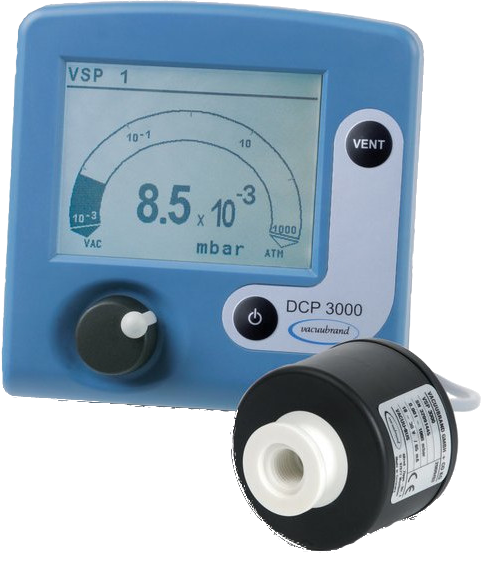vacuubrand library
Project description
Vacuubrand library
This library is used to control basic features of a Vacuubrand controller.
It is composed of a core library, an optional simulator and an optional tango device server.
So far only the DCP 3000 is supported.
Installation
From within your favorite python environment type:
$ pip install vacuubrand
Library
The core of the vacuubrand library consists of DCP3000 object. To create a DCP3000 object you need to pass a communication object.
The communication object can be any object that supports a simple API consisting of two methods (either the sync or async version is supported):
write_readline(buff: bytes) -> bytesorwrite(buff: bytes) -> Noneor
Usually you end up using a connio.connection_for_url() object.
Here is how to connect to a DCP 3000 controller:
import asyncio
from connio import connection_for_url
from vacuubrand.dcp3000 import DCP3000
async def main():
# could also be a socket bridge: 'serial-tcp://<host>:<port>'
comm = connection_for_url('serial:///dev/ttyS0')
dcp = DCP3000(comm)
print(await dcp.pressure())
asyncio.run(main())
Serial line
To access a serial line based DCP 3000 device it is strongly recommended you spawn a serial to tcp bridge using ser2net or socat
Assuming your device is connected to /dev/ttyS0 and the baudrate is set to 19200,
here is how you could use socat to expose your device on the machine port 5000:
socat -v TCP-LISTEN:8500,reuseaddr,fork file:/dev/ttyS0,rawer,b19200,cs8,eol=10,icanon=1
The equivalent line in ser2net config file would be:
8500:raw:0:/dev/ttyR15:19200 8DATABITS NONE 1STOPBIT
It might be worth considering starting socat or ser2net as a service using supervisor or circus.
Simulator
A DCP 3000 simulator is provided.
Before using it, make sure everything is installed with:
$ pip install vacuubrand[simulator]
The sinstruments engine is used.
To start a simulator you need to write a YAML config file where you define how many devices you want to simulate and which properties they hold.
The following example exports 2 hardware devices. The first is a minimal configuration using default values and the second defines some initial values explicitly:
# config.yml
devices:
- class: DCP3000
package: vacuubrand.simulator
transports:
- type: serial
url: /tmp/dcp3000-1
To start the simulator type:
$ sinstruments-server -c ./config.yml --log-level=DEBUG
2020-07-02 12:18:45,065 INFO simulator: Bootstraping server
2020-07-02 12:18:45,065 INFO simulator: no backdoor declared
2020-07-02 12:18:45,065 INFO simulator: Creating device DCP3000 ('DCP3000')
2020-07-02 12:18:45,067 INFO simulator: Created symbolic link "/tmp/dcp3000-1" to simulator pseudo terminal '/dev/pts/7'
2020-07-02 12:18:45,067 INFO simulator.DCP3000[/tmp/dcp3000-1]: listening on /tmp/dcp3000-1 (baud=None)
(To see the full list of options type sinstruments-server --help)
You can access it as you would a real hardware:
$ miniterm.py -e --eol CRLF /tmp/dcp3000-1
IN_PV_1
1004.1 mbar
or using the library:
$ python
>>> from connio import connection_for_url
>>> from vacuubrand.dcp3000 import DCP3000
>>> conn = connection_for_url("serial:///tmp/dcp3000-1")
>>> dcp = DCP3000(conn)
>>> print(await dcp.actual_pressure())
1004.1
Tango server
A tango device server is also provided.
Make sure everything is installed with:
$ pip install vacuubrand[tango]
Register a Vacuubrand tango server in the tango database:
$ tangoctl server add -s Vacuubrand/test -d DCP3000 test/dcp3000/1
$ tangoctl device property write -d test/dcp3000/1 -p url -v "/dev/ttyS0"
(the above example uses tangoctl. You would need
to install it with pip install tangoctl before using it. You are free to use any other
tango tool like fandango or Jive)
Launch the server with:
$ Vacuubrand test
Project details
Download files
Download the file for your platform. If you're not sure which to choose, learn more about installing packages.
Source Distribution
File details
Details for the file vacuubrand-2.1.3.tar.gz.
File metadata
- Download URL: vacuubrand-2.1.3.tar.gz
- Upload date:
- Size: 10.7 kB
- Tags: Source
- Uploaded using Trusted Publishing? No
- Uploaded via: twine/3.4.1 importlib_metadata/4.0.1 pkginfo/1.7.0 requests/2.25.1 requests-toolbelt/0.9.1 tqdm/4.60.0 CPython/3.9.2
File hashes
| Algorithm | Hash digest | |
|---|---|---|
| SHA256 | b7f93a6ca1f20a1bb858b9a11fa63f2957d4696454b084a7b3ccaa52bf2faefd |
|
| MD5 | dc30cb2a2825841375ac93779b770217 |
|
| BLAKE2b-256 | 7eb47c04b90b9b2330363a5f0ec233b540e0808807f31858ddc3860a71ff0d10 |













